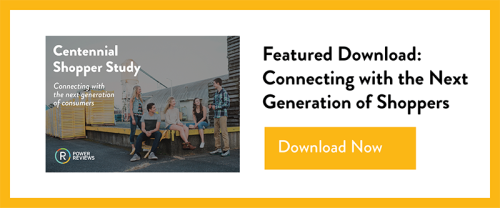Thanksgiving is already next week which means that the busiest shopping season of the year will soon be upon us. As you’re working hard to prepare your website and your stores for the surge in holiday traffic, be sure you’re factoring in the shopping habits of the newest generation of shoppers: Centennials (aka Generation Z).
Today, Centennials, who were born around the turn of the century, make up a quarter of the population. And already these young consumers have $44 million in annual spending power…not to mention a heavy influence on their parents’ spending.
PowerReviews recently surveyed more than 1,000 Millennial and Centennial consumers to better understand their shopping habits. Check out the infographic below for a snapshot of the study’s key findings. Then read on for six tips based on this research for effectively reaching Centennial consumers this holiday season — and beyond.

1. Make Reviews Front and Center
Reviews are an expected part of the shopping experience for Gen Z. In fact, 95% of Centennials search and read reviews before making a purchase, and nearly two thirds read at least four reviews before converting. What’s more, nearly half of Centennials say they won’t purchase a product if there aren’t enough reviews.
This holiday season (and throughout the year), make sure product reviews are prominently featured on your website, both on the product page and beyond. In addition to providing young shoppers with the information they’re looking for, featuring reviews on your site also improves SEO. On average, when a product adds one or more reviews, the product page experiences a 108% lift in traffic.
2. Optimize Your Online Presence for Mobile
Centennials are connected consumers — most don’t remember a time before mobile phones, social media and the internet. Today, mobile accounts for 52% of their time spent online daily, which adds up to an average of 4 hours and 10 minutes spent on mobile each day. And this generation is using their mobile phones for just about everything — including shopping for products. In fact, 37% of Centennials prefer to research and browse for products on mobile devices.
In order to appeal to the next generation of shoppers, ensure your website is mobile optimized so it loads quickly and is easy to view and navigate wherever your customer is.
3. Feature User-Generated Visual Content
Visual content — such as photos and videos — have become an integral part of the lives of today’s consumers. This is especially true for young consumers, who are heavy users of visual-based social media channels such as Instagram and Snapchat. Gen Z shoppers have also come to expect visual content when they’re shopping for products — and they’re not satisfied by photos provided by the brand or retailer. In fact, 40% of Centennials won’t purchase a product if there are no photos of people using the product.
So don’t limit your consumers to text-only reviews, especially when targeting Gen Z shoppers. Make it easy for consumers to submit visual content, such as photos and videos, along with their reviews. Then, display this visual content in a compelling way on your product pages. Seeing other consumers using your products “in real life” will give young shoppers the confidence they need to convert.
4. Answer Centennials’ Questions
No matter how comprehensive your product information, consumers are going to occasionally have questions. And consumers want an avenue to get answers to these questions. Our research found that nearly half (45%) of Centennials won’t buy a product if they can’t ask a question about it. And 79% will go straight to another retailer or to Amazon if they can’t ask a question on a product page.
Add Q&A software to your website to allow your consumers — Centennials or otherwise — to get answers to the questions that stand in the way of making a purchase. Otherwise, you’ll lose them to a brand that does. And be sure to ask potential Q&A vendors if they allow previous customers to answer incoming questions, which is key because nearly two thirds of Centennials prefer having their questions answered by previous customers rather than the retailer.
5. Embrace Transparency
Why do Centennials turn to reviews? Because of their authenticity. While you never want to aim for negative reviews, displaying all reviews — both negative and positive — helps consumers identify the products that best fit their needs. And it also helps you earn the trust of consumers. In fact, 44% of Centennials say they wouldn’t trust a product’s reviews if there were no negative reviews present, and 60% read negative reviews first.
So be sure you’re displaying these reviews — regardless of sentiment. In addition, remember to badge all reviews that have been written as the result of a product sampling campaign or an incentive program so future shoppers have a clear understanding of who wrote each review.
6. Don’t Overlook Brick-and-Mortar
Our research found that while the majority of Centennials research and browse products online, when it’s time to make a purchase, 46% prefer to go in-store. And according to research from IBM, more Centennials shop in-store during the holidays than any other generation.
Look for opportunities to display user-generated content — such as ratings and reviews — in your stores to attract and convert in-store shoppers. For example, highlight star ratings and customer reviews alongside top-selling products to give your customers the confidence they need to make a purchase.
Wrapping Up
This holiday season, make sure you have a strategy in place to engage Centennial shoppers.






